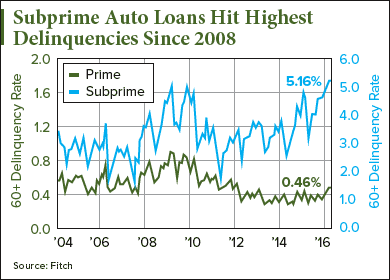During the zero-interest-rate years, the markets tended to react to any positive news in the economy by heading down in a “good news is bad news” syndrome. Traders and investors only managed to shake this over the last year.
Events have shown that the markets are moving on economic optimism now and can therefore handle interest rate normalization. What’s more, the Fed has been pretty transparent about its plans to hike rates in the face of stronger economic and employment data and rising inflation, so last week’s rate hike was largely priced in.
So “good news is good news” again…
…unless you happen to be invested in one $570 billion sector. It might not survive the next Fed move toward normalization – a move I’m certain is coming this year.
In fact, this industry could be another 0.25% rate hike away from exploding altogether…
This Is the Next "Subprime Bubble"
Whether it’s for status, safety, or reliability, people are always looking for newer and better cars to drive.
But most people typically don’t walk into a dealership and put down a stack of cash for their vehicle of choice – so they finance their cars.
The problem is, not everyone can get approval for the amount they need (if at all)… This is where subprime auto loans come into play.
A subprime auto loan is used to approve people with less-than-perfect credit scores or a limited credit history who need to buy a car. This type of loan typically carries much higher interest rates and may also include pre-payment penalties.
Of course, given these higher rates, subprime auto loans are among the most sensitive to interest rate changes.
Now one could argue that subprime auto loans helped propel auto sales in the United States, but it didn’t come without risk – and that risk is growing by the day…
 Back in February 2016, one of the “Big Three” credit bureaus, Experian, reported that auto loan delinquencies had hit a six-month high. Of those loans, nearly 5% of subprime loans were delinquent by 60 days or more – the highest level since 2008 at that time.
Back in February 2016, one of the “Big Three” credit bureaus, Experian, reported that auto loan delinquencies had hit a six-month high. Of those loans, nearly 5% of subprime loans were delinquent by 60 days or more – the highest level since 2008 at that time.
Financial professionals worried about the potential of those bad loans being packaged up and sold as securities… Just like the subprime mortgage-backed securities that led directly to the Financial Crisis.
If that repackaging did happen, and there’s a very real risk it will, the entire auto industry faces the risk of collapsing.
Late Payments Are Spiraling, Red Lights Are Flashing
[mmpazkzone name="in-story" network="9794" site="307044" id="137008" type="4"]
Just this month, Experian reported that U.S. subprime auto loans delinquencies are even higher than they were before the financial crisis about eight years ago.
Losses for these loans came in at 9% in January, up from 7.9% in January 2016. Even worse, it’s reporting recoveries dropped to 34.8% – the worst since early 2010.
And this is only the beginning…
Banks and finance lenders are expecting their losses in the subprime areas to increase even further. Investors in bonds backed by these loans want higher yields, which would drive up borrowing costs for banks and lenders.
Put simply, they’re losing profits – and it will likely just get worse if the Fed sticks to its guns to raise interest rates aggressively.
Now, enough of these delinquent loans floating around bundled into asset-backed securities could disrupt the economy again, and that would be the other knockdown blow for the auto industry.
The longtime practice of lending money to people who can’t afford it, and not providing reasonable alternatives, has brought us to this point – again.
What’s more, if delinquencies come to a head, repossessions will rise steadily, and lots of folks will be left high and dry, without the ability to go to work and provide for their families.
At the same time, financial stocks are strong and getting stronger (this is a rising rate environment, after all), making them attractive to buy-and-hold investors.
That means it’s absolutely critical to do your homework before you buy or get into a trade. If you’re going long, you want to make absolutely certain the bank or lender you’re buying has very limited or no exposure to the subprime segment.
Investors looking to double their money on the auto sector likely have another thing coming, but folks who follow Tom Gentile’s recommendations could double their money week after week. In fact, there are some weeks where $500 could have returned as much as $3,956. This is some seriously fast-growing income potential. Check it out…
About the Author
Tom Gentile, options trading specialist for Money Map Press, is widely known as America's No. 1 Pattern Trader thanks to his nearly 30 years of experience spotting lucrative patterns in options trading. Tom has taught over 300,000 traders his option trading secrets in a variety of settings, including seminars and workshops. He's also a bestselling author of eight books and training courses.



